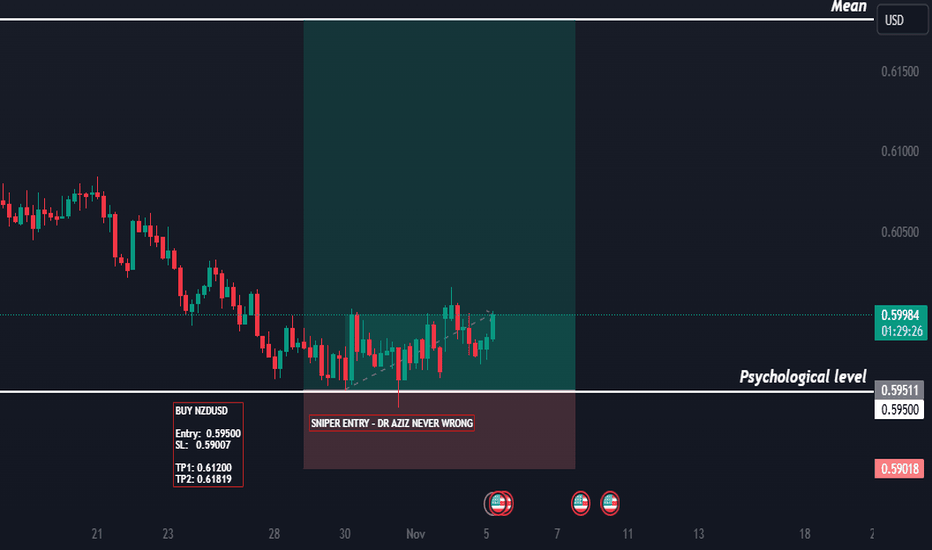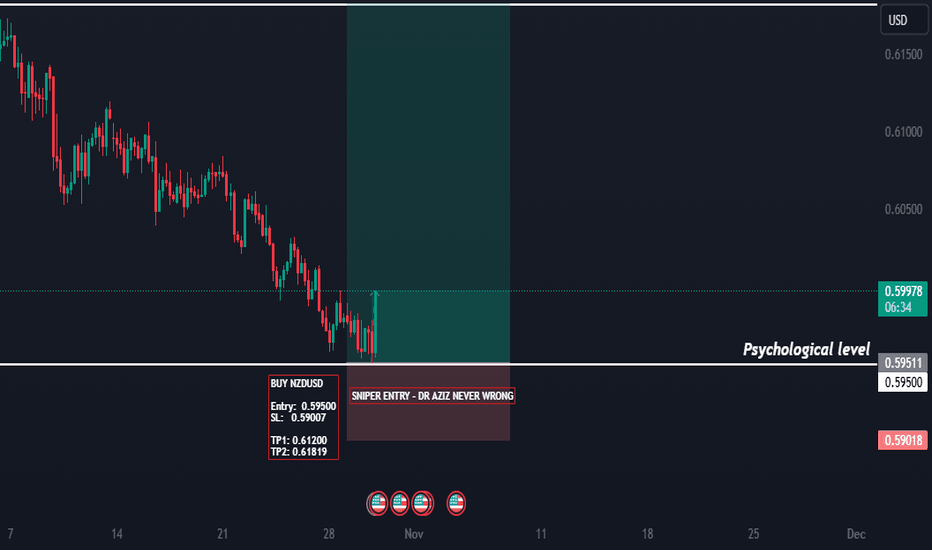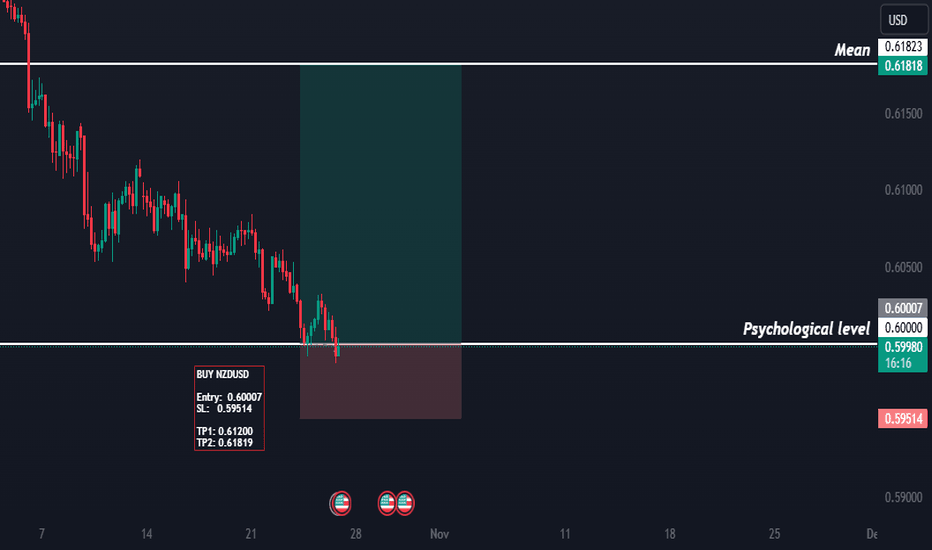NZDUSD Slightly Bullish Bias Today: Key Fundamental Drivers !Introduction
Today, the NZDUSD currency pair shows a slightly bullish bias, supported by fundamental factors in the current market conditions. Traders are closely monitoring the New Zealand dollar's performance against the US dollar, as it provides valuable insight into the economic trends in both countries. In this analysis, we’ll break down the key drivers likely to influence NZDUSD today and explore whether a bullish stance is justified.
---
Key Factors Driving NZDUSD Bullish Bias
1. New Zealand Economic Data and Market Sentiment
The NZDUSD is benefiting from positive sentiment around recent New Zealand economic data. In the last few weeks, upbeat employment numbers and stable inflation indicators have bolstered confidence in New Zealand’s economic resilience. The recent jobs report revealed an increase in labor force participation and a decline in the unemployment rate, which suggests stronger consumer spending and economic stability. This environment supports demand for the New Zealand dollar, as traders expect a steady economic performance.
2. US Dollar Weakness Amid Mixed Data
The US dollar’s recent struggles play a significant role in NZDUSD’s bullish outlook. Recent US data releases, including mixed non-farm payrolls and a below-expectation ISM Manufacturing PMI, signal an uneven recovery in the US economy. Additionally, traders are beginning to anticipate that the Federal Reserve may hold off on further interest rate hikes, putting downward pressure on the US dollar. This outlook supports a bullish sentiment for NZDUSD, as reduced rate hike expectations make the New Zealand dollar more attractive in comparison.
3. Commodity Prices and Global Trade Trends
New Zealand's economy is heavily commodity-dependent, and rising global dairy and meat prices provide a tailwind for the NZD. Furthermore, the recent uptick in global trade volumes is particularly favorable for New Zealand, which relies heavily on exports. The improved demand in key markets for New Zealand exports, like China and Australia, strengthens the economic outlook, reinforcing the NZD and contributing to the bullish bias for NZDUSD.
4. Interest Rate Differential and Central Bank Policies
The Reserve Bank of New Zealand (RBNZ) has maintained a hawkish stance relative to the Federal Reserve, and this divergence is crucial for traders betting on the NZDUSD. The RBNZ’s approach to keeping interest rates elevated amidst inflation control efforts indicates support for the NZD. With the Fed showing signs of a more dovish outlook and potential rate cuts in 2025, the interest rate differential could favor a stronger New Zealand dollar against the US dollar.
5. Global Risk Sentiment and Safe-Haven Dynamics
The NZD often benefits during periods of strong global risk sentiment, while the USD’s safe-haven appeal wanes. Given the relatively calm market sentiment today, risk-sensitive currencies like the NZD tend to attract buyers, while the USD may face pressure. If this positive risk sentiment continues, the NZDUSD could maintain its upward bias.
---
Technical Outlook for NZDUSD
From a technical analysis perspective, NZDUSD is trading near key support levels, which align with the fundamental bias for a slight bullish trend. Key resistance levels around 0.6000 may be tested if the current bullish momentum sustains. Traders are watching for breakout signals that could indicate further upside potential, with support levels near 0.5930 expected to provide a floor if the pair faces minor pullbacks.
---
Conclusion
In summary, a combination of supportive economic data from New Zealand, US dollar weakness, favorable commodity prices, interest rate differentials, and risk-on sentiment underpin today’s slightly bullish outlook for NZDUSD. As these factors continue to influence market sentiment, NZDUSD could see moderate gains if bullish momentum holds. Traders should keep an eye on any shifts in US economic data and central bank communications, which could impact this bias.
---
SEO Tags:
#NZDUSDAnalysis
#NZDUSDForecast
#NZDUSDToday
#NZDUSDFundamentalAnalysis
#USDollarWeakness
#NewZealandDollar
#ForexMarketUpdate
#TradingNZDUSD
#NZDUSDBullishBias
Nzdusdbullishbias
NZDUSD Analysis: Potential Bullish Bias for October 30, 2024Discover the latest analysis on NZDUSD and explore the key market drivers that could impact the pair’s movements today. Is NZDUSD gearing up for a bullish trend?
---
Introduction
Today, October 30, 2024, NZDUSD could present a slight bullish bias, driven by key macroeconomic developments and currency market sentiment. In this article, we will analyze the factors influencing the potential appreciation of the New Zealand dollar (NZD) against the U.S. dollar (USD), including central bank policies, economic data releases, and general risk sentiment. For those tracking NZDUSD, these insights provide an up-to-date perspective for informed trading decisions.
Current Market Sentiment
The global financial market sentiment remains cautiously optimistic, reflecting a slight increase in risk appetite, which generally favors higher-yielding currencies like the NZD. A rebound in commodity prices also supports the New Zealand dollar, as New Zealand’s economy is heavily commodity-dependent, notably in dairy, forestry, and agriculture. This positive sentiment may give a short-term boost to NZDUSD, particularly as investors look to diversify amid uncertain U.S. economic data.
Key Drivers Influencing NZDUSD
1. RBNZ Policy Outlook
Recent signals from the Reserve Bank of New Zealand (RBNZ) suggest a steady stance, with the central bank keeping a cautious eye on inflation while avoiding any immediate rate hikes. The RBNZ’s approach is contrasting with the recent hawkishness from the Federal Reserve, yet a positive growth outlook in New Zealand still supports the Kiwi dollar. If the RBNZ indicates stability, NZDUSD may see a lift as investors view the NZD as an attractive option in a low-volatility environment.
2. U.S. Federal Reserve Policy and Economic Data
The U.S. Federal Reserve’s interest rate path continues to be a decisive factor in determining NZDUSD trends. If the Fed's upcoming economic data releases hint at any economic cooling, it could reduce demand for the U.S. dollar, potentially encouraging NZDUSD to move higher. Investors should keep an eye on any U.S. economic updates today, particularly in employment or inflation, as they might temper the USD's strength and further support the NZD.
3. Commodity Price Trends
As a key exporter of commodities, New Zealand’s dollar is highly correlated with global commodity price trends. A recent uptick in dairy prices, New Zealand’s primary export, has lent support to the NZD, as has a steady demand for agricultural and forestry products. If commodity prices maintain an upward trajectory, this could strengthen the New Zealand dollar, pushing NZDUSD higher.
4. Risk Sentiment and Geopolitical Considerations
Risk sentiment plays a crucial role in NZDUSD’s movement, as the New Zealand dollar is often viewed as a “risk-on” currency. Current stability in geopolitical factors, along with market optimism in global growth prospects, could continue to attract buyers to the NZD. Positive developments from Asian markets or constructive trade discussions could offer additional support to the NZD.
Technical Overview
The technical picture for NZDUSD also indicates potential for a slight upward bias. With NZDUSD hovering near a support level and moving averages hinting at a potential breakout, bullish momentum could drive the pair higher. Traders may want to watch for any break above the 50-day moving average as a potential entry point for a long position.
Conclusion
Overall, the NZDUSD outlook for today suggests a slight bullish bias, supported by a favorable risk sentiment, steady commodity prices, and nuanced central bank positions. While uncertainties remain, particularly with U.S. data releases, the fundamentals provide a supportive environment for a mild upward movement in NZDUSD.
Remember to follow this NZDUSD forecast closely to stay updated on any shifts in market sentiment or fundamental data impacting this currency pair.
SEO Keywords:
NZDUSD analysis,
NZDUSD today,
New Zealand dollar forecast,
NZDUSD bullish bias,
Reserve Bank of New Zealand policy,
Commodity prices,
Forex trading NZDUSD,
NZDUSD technical analysis,
NZDUSD forecast,
tradingview.
NZDUSD: Potential for Slight Bullish Bias Amid Key Fundamental !NZDUSD: Potential for Slight Bullish Bias Amid Key Fundamental Drivers (25/10/2024)
Today, the NZDUSD currency pair shows potential for a slight bullish bias, influenced by a blend of fundamental factors and evolving market conditions. Let's dive into the primary drivers impacting the New Zealand Dollar to US Dollar (NZDUSD) pair today and assess whether the bullish sentiment could hold.
1. New Zealand's Economic Data and RBNZ Stance
The Reserve Bank of New Zealand (RBNZ) has maintained a balanced tone on interest rates amid recent economic data. Despite slower-than-expected growth figures, the New Zealand economy demonstrates resilience in key sectors like exports and services, which might provide support for the NZD. Market expectations for RBNZ’s neutral-to-hawkish stance add a slight bullish outlook for the NZD, as investors anticipate steady policy moves that avoid aggressive tightening while also signaling confidence in the economy’s fundamentals.
2. US Dollar Moderation Amid Potential Fed Pause
The US Dollar Index (DXY) has shown signs of consolidation as Federal Reserve officials continue to weigh the potential for a pause in rate hikes. Recently, the USD’s bullish momentum has softened, with investors focusing on US inflation data that suggests a gradual cooling, potentially easing pressure on the Fed to maintain a tight monetary policy stance. This development could limit the USD’s strength, lending support to a slight upside for NZDUSD as investors look for alternative assets.
3. China’s Economic Resilience and Impact on NZD
China, as New Zealand's primary trading partner, influences the NZD through commodity prices and trade flows. Recent signs of resilience in China’s economy, particularly in industrial production and retail sales, may boost market sentiment for currencies like the NZD, as stronger demand for New Zealand’s exports could improve trade dynamics. This positive external factor indirectly supports the NZD, making NZDUSD slightly more appealing in today’s trading landscape.
4. Technical Levels and Market Sentiment for NZDUSD
On the technical analysis front, NZDUSD has shown support near the 0.5850 level, with a potential resistance zone around 0.5950. Should the pair break above the 0.5900 mark, we could see momentum strengthening, bolstered by the factors discussed. RSI indicators are also neutral, suggesting room for upward movement without immediate overbought concerns. A slight bullish bias may prevail, provided these technical and sentiment indicators remain supportive.
Summary: Slight Bullish Bias for NZDUSD
In summary, NZDUSD could hold a slight bullish bias today, with influences from New Zealand’s resilient economy, a softer USD, and supportive technical indicators. Traders might find opportunities if bullish momentum strengthens, keeping an eye on US Dollar trends, RBNZ announcements, and China's economic performance for additional cues.
Keywords:
1. NZDUSD forecast
2. New Zealand Dollar analysis
3. US Dollar impact
4. RBNZ policy stance
5. NZDUSD technical levels
6. Forex trading insights
7. Federal Reserve impact
8. China economy influence
9. NZDUSD bullish bias


